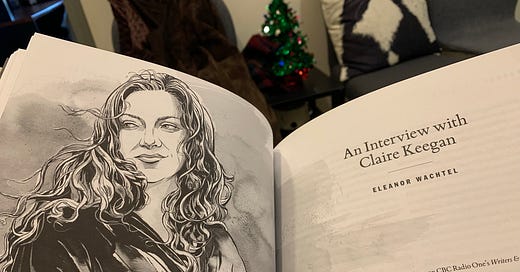the green notebook
, reading through Eleanor Wachtel's interview with Claire Keegan, in Brick: A Literary Journal,
Lemonade’s remains are ready to collect from the Emergency Vet Hospital. We had him cremated, with a small plaster cast of a single paw-print. His polydactyl toes. When I arrive, a sign on the door that prompts: Ask us to confirm if your pet is the proper weight.
I’m handed a small urn, marked with Lemonade’s name. It weighs far less than my father did, following his own cremation. Is Lemonade the proper weight?
*
I’m reading through an interview CBC Radio legend Eleanor Wachtel conducted with Irish writer Claire Keegan in the latest issue of Brick: A Literary Journal. Due to the four weeks of the ongoing Canada Post strike, my copy hand-delivered into our mailbox, as poet and Brick publisher Laurie D. Graham is in town attending meetings at the Canada Council. Non-Ottawa subscribers will just have to wait. Her car easing out of our driveway before I could catch her.
I haven’t read Keegan’s work, but this interview makes me curious. I’m appreciating the familiar approaches she describes to working characterization in fiction, offering small details of perspective that open up whole possibilities. Keegan mentions a friend who had read through a draft of a story, asking why her main character, given they were in a particular locale, hadn’t noticed all the cars going by. “I tried doing that,” Keegan explains, “and then I realized he didn’t really look up. He’s a man who looks down and looks ahead only to see where he needs to get to on that particular day.” It seems an important and even nuanced detail, one that opens up both character and back-story, both of which can’t help but determine any forward momentum. The implications of such a tiny element.
She also describes how she sees the difference between composing novels to composing short stories. “The short story begins after what’s happened has happened; the drama is over.” Whereas she describes how the novel is built around how a particular drama unfolds and occurs, the short story focuses instead on the aftermath. “I’m attracted to the consequences,” she says, “but not the drama so much. Drama can be terribly tedious to read. I’m far more interested in tension and loss: how we lose, and how we lose our composure while we’re losing.”
As I worked my five years on the novel Missing Persons, discovering that I worked best not in action, but on either side of an action indirectly described: leading up to and away from something that is, by itself, far less interesting than how one gets there, or what happens after. At first, this was because I considered myself unable to flesh out a proper action, possibly convincing myself of the sour grapes that action itself is less compelling. Is that all I did?
At one point in the interview, Keegan mentions a familiar landmark:
There’s a Philip Larkin poem called “An Arundel Tomb,” and it’s a beautiful one. It ends with the line “What will survive of us is love.”





Eleanor's still doing her great interviews (just not on the radio anymore).
Special delivery!